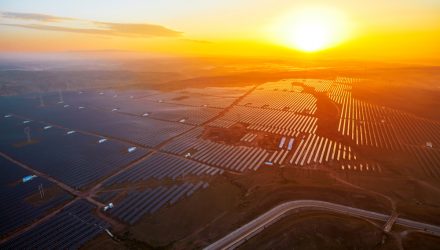How the world consumes and generates energy is heavily rooted in fossil fuels such as coal, natural gas, and oil, but that’s changing as more corporations and governments trumpet carbon reduction and net zero ambitions.
Savvy investors know corporate and government entities can easily talk the talk when it comes to renewable energy adoption. Walking the walk is a different ballgame, and expensive one at that. Those expenditures are among the long-term catalysts for exchange traded funds such as the KraneShares Global Carbon Transformation ETF (KGHG).
KGHG is an actively managed ETF — a relevant trait because there are varying avenues through which companies and governments can attack carbon reduction agendas. KGHG member firms are those “with a stated commitment and demonstrated action towards decarbonization may see superior growth compared to their peers and their own histories as well as be revalued as their businesses become ‘greener,” according to KraneShares.
KGHG’s status as an actively managed fund is relevant for another reason: that management style could position the fund to more swiftly capitalize on major climate-related spending initiatives, such as the Inflation Reduction Act and the European REPowerEU, than passive peers.
“The effect of these programs, which offer financial incentives across a range of energy and industrial sectors, will be the rapid adoption and deployment of electrification technologies and processes. Fearful of losing these large new industries to other regions, governments are in an ‘arms race’ to throw capital at the energy transition value chain,” noted KraneShares portfolio manager Roger Mortimer.
KGHG’s structure is pertinent on another front. Companies in “high impact industries” have extensive room ahead to improve carbon reduction capabilities. Those efforts will be expensive, but these firms are getting some help from governments and that could pay dividends for investors over the long haul.
“Governments are showering them with money, tilting the economics of decarbonization in their favor, and facilitating capital allocation decisions. The effect is a long runway of opportunity: a chance to rebuild themselves entirely in a huge investment cycle that will drive earnings growth,” added Mortimer.
For novice and experienced investors alike, understanding how KGHG attempts to deliver upside is easier than meets the eye. The thesis companies that have long been carbon-intensive have the potential to reward investors as these firms increasingly emphasize decarbonization plans.
“For the incumbent emitters, the idea of getting greener has multiple benefits: faster growth, possible market share gain from slower moving competitors, the potential for margin expansion as growing scale drives down new technology costs, lower-cost access to capital, and a growing shareholder universe, implying potentially higher valuation,” concluded Mortimer.
For more news, information, and analysis, visit the Climate Insights Channel.
The opinions and forecasts expressed herein are solely those of Tom Lydon, and may not actually come to pass. Information on this site should not be used or construed as an offer to sell, a solicitation of an offer to buy, or a recommendation for any product.

